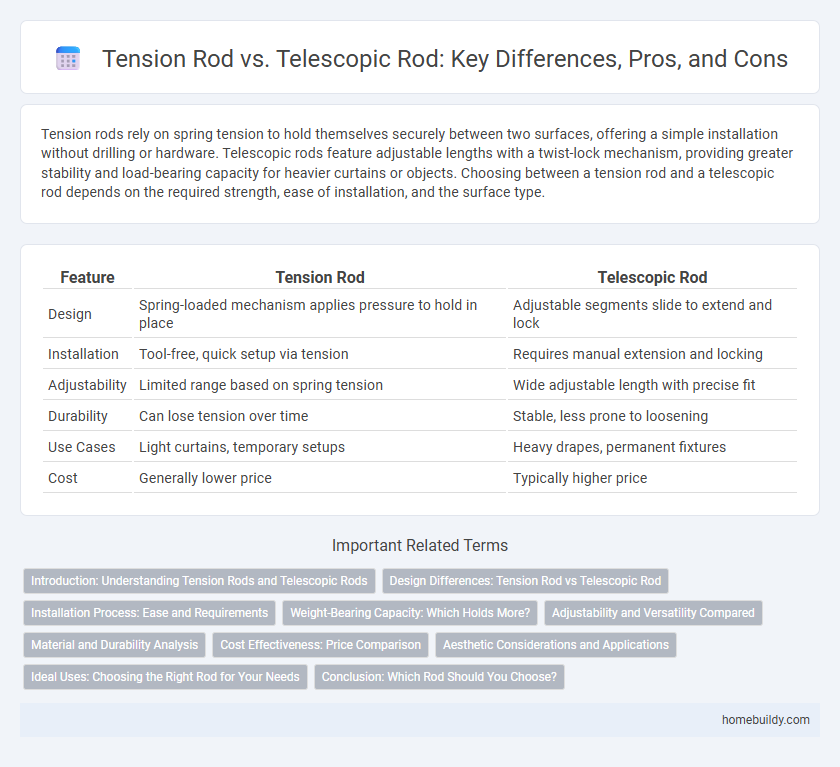Tension rods rely on spring tension to hold themselves securely between two surfaces, offering a simple installation without drilling or hardware. Telescopic rods feature adjustable lengths with a twist-lock mechanism, providing greater stability and load-bearing capacity for heavier curtains or objects. Choosing between a tension rod and a telescopic rod depends on the required strength, ease of installation, and the surface type.
Table of Comparison
| Feature | Tension Rod | Telescopic Rod |
|---|---|---|
| Design | Spring-loaded mechanism applies pressure to hold in place | Adjustable segments slide to extend and lock |
| Installation | Tool-free, quick setup via tension | Requires manual extension and locking |
| Adjustability | Limited range based on spring tension | Wide adjustable length with precise fit |
| Durability | Can lose tension over time | Stable, less prone to loosening |
| Use Cases | Light curtains, temporary setups | Heavy drapes, permanent fixtures |
| Cost | Generally lower price | Typically higher price |
Introduction: Understanding Tension Rods and Telescopic Rods
Tension rods utilize adjustable spring-loaded mechanisms to create pressure between two surfaces, providing a stable hold without permanent fixtures. Telescopic rods extend and retract through interlocking sections, allowing for customizable length but often requiring manual tightening for stability. Both types offer versatile solutions for hanging curtains or securing objects, but tension rods excel in ease of installation while telescopic rods provide greater length flexibility.
Design Differences: Tension Rod vs Telescopic Rod
Tension rods rely on a spring mechanism to create pressure between two surfaces, allowing quick installation without screws, while telescopic rods extend by sliding sections for adjustable length with locking mechanisms. The design of tension rods often features a fixed length with a high-tension spring inside, optimized for lightweight applications, whereas telescopic rods prioritize versatility with multiple adjustable segments ideal for heavier loads. Material composition for tension rods typically involves lightweight metals like aluminum, whereas telescopic rods may use reinforced steel or alloy for enhanced durability and stability.
Installation Process: Ease and Requirements
Tension rods typically offer a straightforward installation process requiring no drilling or permanent fixtures, making them ideal for renters or temporary setups. Telescopic rods also feature easy, drill-free installation but may involve adjustable components that require precise alignment for optimal tension and stability. Both options prioritize minimal tool use, but tension rods generally demand less skill and fewer adjustments during setup.
Weight-Bearing Capacity: Which Holds More?
Tension rods rely on pressure between two surfaces to stay in place, typically supporting lighter loads up to 15-20 pounds, making them suitable for curtains and lightweight items. Telescopic rods feature adjustable lengths with internal locking mechanisms, offering higher weight-bearing capacity generally ranging from 30 to 50 pounds, ideal for heavier drapes or storage solutions. Choosing between the two depends on the specific requirements for strength, with telescopic rods providing superior load support and tension rods best for minimal weight applications.
Adjustability and Versatility Compared
Tension rods offer fixed length options with limited adjustability, making them ideal for straightforward installations without precise length requirements. Telescopic rods provide superior adjustability through extendable sections, accommodating a wider range of window sizes and irregular spaces. This versatility makes telescopic rods more suitable for dynamic environments where customizable fit and frequent adjustments are necessary.
Material and Durability Analysis
Tension rods are commonly made from high-strength steel or aluminum alloys, offering superior load-bearing capacity and resistance to bending under tension. Telescopic rods typically use lighter materials such as aluminum or plastic composites, prioritizing adjustability over maximum durability. When assessing durability, tension rods excel in long-term structural applications due to their robust material composition, while telescopic rods may experience wear and reduced strength from repeated adjustments.
Cost Effectiveness: Price Comparison
Tension rods generally offer a more budget-friendly option compared to telescopic rods due to their simpler design and fewer adjustable components. Telescopic rods tend to be pricier because of their extendable features and higher-quality materials that allow for flexibility in length. For cost-conscious buyers, tension rods provide a reliable and economical solution without compromising basic functionality.
Aesthetic Considerations and Applications
Tension rods provide a sleek, minimalist look ideal for lightweight curtains and small spaces, while telescopic rods offer adjustable length and stronger support for heavier drapes, making them versatile for various room sizes. Tension rods are perfect for temporary or rental settings where wall damage must be minimized, whereas telescopic rods suit permanent installations requiring durability and aesthetic customization. Both types accommodate different design preferences, but telescopic rods often feature decorative finials enhancing room decor compared to the simpler profile of tension rods.
Ideal Uses: Choosing the Right Rod for Your Needs
Tension rods are ideal for lightweight applications such as hanging curtains or shower curtains in small to medium-sized spaces where fixed length is sufficient. Telescopic rods offer adjustable length capabilities, making them perfect for varied window sizes or areas requiring frequent repositioning without the need for hardware installation. Selecting between tension rods and telescopic rods depends on the desired flexibility, load capacity, and installation ease specific to your home or office environment.
Conclusion: Which Rod Should You Choose?
Tension rods provide strong, fixed support ideal for heavy curtains but require precise measurement and installation, ensuring durability and stability. Telescopic rods offer adjustable length and easy installation without tools, making them perfect for lightweight curtains or temporary setups. Choose tension rods for permanent, heavy-duty use and telescopic rods for flexibility and convenience in varying window sizes.
Tension rod vs Telescopic rod Infographic

 homebuildy.com
homebuildy.com